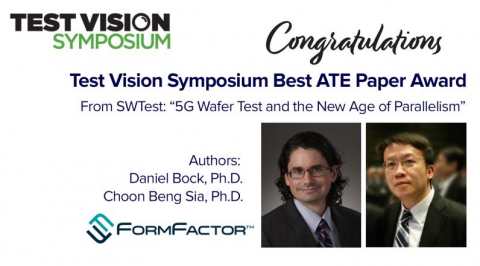A big CONGRATULATIONS to Daniel Bock, Ph.D. and Choon Beng Sia, Ph.D. on capturing the Test Vision Symposium Best ATE Paper Award for their paper – 5G Wafer Test and the New Age of Parallelism.
Their paper explores the ins and outs of 5G and covers what probing technology you can use at these frequencies, what you need to think about for probe head inductance, and what Figures of Merit (FOM) are important for 5G probe cards.
In both engineering characterization and production, the challenge of testing 5G devices is how to test a broad spectrum including higher frequencies while maintaining high throughput. With the significant increase in test content that 5G brings, we are developing ways to provide fast, accurate measurements on 5G devices and accelerate time to market.

The net result is that any probe card technology needs to be capable in the test environment, including signal integrity, multi-site capabilities, high channel count capable in arrays, and of course the lowest cost of test possible for the use case at hand.
The paper also explores the appropriate FOM for the different types of tests to evaluate the capability of probe cards – S-parameters, eye diagrams, and constellation diagrams.
As 5G moves forward, we are fully committed to collaborating with leading manufacturers to develop innovative test and measurement approaches that will support the enormous infrastructure required to fulfill its exciting promise.
The development of new RF devices (5G and high-speed digital components) is changing the landscape for RF probing. For many years, RF probing in frequencies beyond cell phone and WiFi frequencies was a niche area, only requiring a very small number of lines as well as not meeting the needs for High Volume Manufacturing (HVM).
You can download this paper here.

